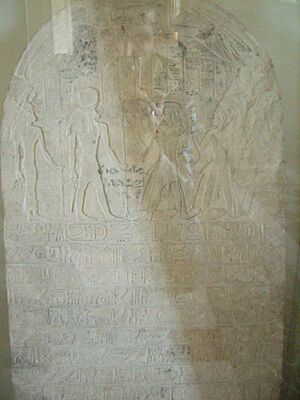Pami facts for kids
Quick facts for kids Pami |
|
|---|---|

Year 2 Apis stela from Pami's reign found in Saqqara. Louvre
|
|
| Pharaoh | |
| Reign | 785 – 778 BC (22nd Dynasty) |
| Predecessor | Shoshenq IV |
| Successor | Shoshenq V |
| Burial | NRT II, Tanis |
Pami was an ancient pharaoh who ruled ancient Egypt for about seven years. He was part of the 22nd Dynasty. His full royal name was Usermaatre Setepenre Pami.
The name "Pami" means "the Cat" in the Egyptian language. It also means "He who belongs to the Cat [Bastet]," who was an Egyptian goddess often shown as a cat.
Contents
Who was Pami?
Historians are not completely sure how Pami was related to the pharaoh before him, Shoshenq IV. However, we do know that Pami was the father of Shoshenq V. This fact comes from a special stone tablet, called a stela, found in a place called the Serapeum of Saqqara.
For a long time, people thought Pami might be the same person as Pimay. Pimay was a son of another pharaoh, Shoshenq III. But Pami and Pimay are actually two different people.
Pami vs. Pimay
The names Pami and Pimay are spelled differently in ancient Egyptian. Pami means 'The Cat,' while Pimay means 'The Lion.' This difference in meaning shows they were not the same person.
Also, if Pimay had lived longer than his father, he probably would have become king. But an unknown pharaoh, Shoshenq IV, ruled instead. This makes it very likely that Pami was not Pimay, the son of Shoshenq III.
Most experts now agree that Pami was not Shoshenq III's son. He might have been the son of his predecessor, Shoshenq IV.
How long did Pami rule?
Pami ruled for almost seven full years. We know this from several ancient records.
Important discoveries
- In Pami's second year as pharaoh, an Apis bull was buried. This event is recorded on a stela found at the Serapeum of Saqqara. Apis bulls were very important sacred animals in ancient Egypt.
- A papyrus document from Brooklyn (called ‘16.205’) tells us about Pami's fourth year.
- A small stone tablet from Memphis mentions a religious ceremony that happened in Pami's sixth year.
Heliopolis records
At Heliopolis, a city in ancient Egypt, parts of a stone block were found. This block recorded events from the 22nd Dynasty. The section about Pami's reign survived.
It describes how Pami made yearly gifts to the gods at the Great Temple of Heliopolis. He also gave gifts to other gods and temples in the city. The record clearly shows a gift made in Pami's seventh year. This suggests he ruled for nearly seven years.
Images for kids
-
Year 2 Apis stela from Pami's reign found in Saqqara. Louvre




